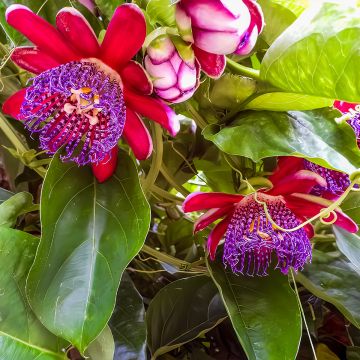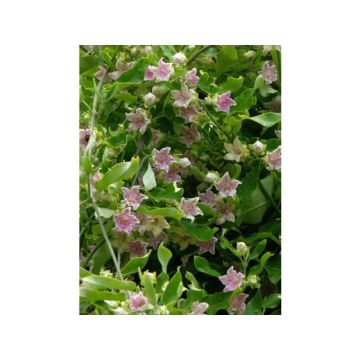

Holboellia traversii - China Bluebell


Holboellia traversii - China Bluebell


Holboellia traversii - China Bluebell
Holboellia traversii - China Bluebell
Holboellia traversii
China Bluebell, Sausage Vine
Special offer!
Receive a €20 voucher for any order over €90 (excluding delivery costs, credit notes, and plastic-free options)!
1- Add your favorite plants to your cart.
2- Once you have reached €90, confirm your order (you can even choose the delivery date!).
3- As soon as your order is shipped, you will receive an email containing your voucher code, valid for 3 months (90 days).
Your voucher is unique and can only be used once, for any order with a minimum value of €20, excluding delivery costs.
Can be combined with other current offers, non-divisible and non-refundable.
Home or relay delivery (depending on size and destination)
Schedule delivery date,
and select date in basket
This plant carries a 6 months recovery warranty
More information
We guarantee the quality of our plants for a full growing cycle, and will replace at our expense any plant that fails to recover under normal climatic and planting conditions.
Would this plant suit my garden?
Set up your Plantfit profile →
Description
Holboellia traversii is the most discreet species in this genus of Asian climbing plants related to Akebia. However, it is as hardy as it is decorative, first with its long, delightfully scented spring to summer flowering, and then with its beautiful tough foliage that persists all year round. Its male and female flowers have different appearances, with a slightly pinkish mauve or greenish-white colour. In the hottest summers, they produce edible fruits that resemble small purple sausages. In the garden, it climbs without suffocating the surrounding bushes, and its moderate growth also allows it to be grown in a container for many years. So many reasons to adopt this small climber, capable of perfuming a whole section of the garden or terrace for several weeks.
Holboellia traversii belongs to the family of Lardizabalaceae. The 5 species in the genus Holboellia are native to Chinese and Himalayan mountain forests. They are little-known but robust climbers that prefer partial shade at the base and full sun at the top, and they tolerate any well-drained soil rich in humus, without excessive limestone, even fairly dry in summer once they are well established.
Holboellia traversii hybrid 'Travers' is one of the least vigorous, but also one of the most cold-resistant, down to -20°C. This woody climber will not exceed 3m in height and 1m in width in our gardens. Its growth rate is moderate. Its leaves are compound, consisting of 3 elliptical to ovate elliptical leaflets, measuring 6 to 10cm in length and 4 to 5cm in width. They are more or less tough and glossy, dark green. This plant produces either male or female flowers, with different appearances, from May to July. The small female, greenish-white flowers, emerge at the base of new shoots, while the more numerous male flowers, slightly pinkish mauve, appear at the ends of twisting branches. They are all delightfully scented and have bell-shaped flowers measuring 1 to 1.6mm in length, consisting only of waxy sepals. The flowers are grouped in clusters. The flowering is followed by the formation of a few purple, oval fruits measuring 4-5cm in length in autumn, which are edible if they ripen.
Holboellia traversii joyfully winds itself up to the top of bushes, perfuming the air several metres around for nearly 2 months. It withstands our winters perfectly and remains beautiful all year round. By training the twining stems as they grow, this plant can be used to cover a trellis on the terrace or the branches of a small tree that becomes bare in winter. It can accompany easy-to-grow small clematis (alpina, integrifolia, viticella, 'Rebecca', tangutica Golden Tiara) or blend in with the flowering of Japanese honeysuckles.
Report an error about the product description
Holboellia traversii - China Bluebell in pictures




Plant habit
Flowering
Foliage
Botanical data
Holboellia
traversii
Lardizabalaceae
China Bluebell, Sausage Vine
West Asia
Other Holboellia
View all →Planting and care
Plant Holboellia traversii in an open location protected from prevailing winds. The plant will flower more when the head is in the sun but the base is slightly shaded, similar to a clematis. However, it can also adapt to partial shade and even shady situations. Plant it in a well-drained, fertile soil rich in humus, without excessive limestone. Once established, Holboellia can tolerate dry summers.
Cultivating it in a pot is easy. Lighten the substrate by incorporating clay pellets or gravel at the bottom of the pot or planting hole. For example, the mixture could consist of 1/3 potting soil, 1/3 garden soil, and 1/3 compost. Train the plant as it grows. Water regularly, especially in hot and dry weather. Holboellia does not require any specific pruning, but you can lightly prune it after flowering, in July.
Planting period
Intended location
Care
This item has not been reviewed yet - be the first to leave a review about it.
Similar products
Haven't found what you were looking for?
Hardiness is the lowest winter temperature a plant can endure without suffering serious damage or even dying. However, hardiness is affected by location (a sheltered area, such as a patio), protection (winter cover) and soil type (hardiness is improved by well-drained soil).

Photo Sharing Terms & Conditions
In order to encourage gardeners to interact and share their experiences, Promesse de fleurs offers various media enabling content to be uploaded onto its Site - in particular via the ‘Photo sharing’ module.
The User agrees to refrain from:
- Posting any content that is illegal, prejudicial, insulting, racist, inciteful to hatred, revisionist, contrary to public decency, that infringes on privacy or on the privacy rights of third parties, in particular the publicity rights of persons and goods, intellectual property rights, or the right to privacy.
- Submitting content on behalf of a third party;
- Impersonate the identity of a third party and/or publish any personal information about a third party;
In general, the User undertakes to refrain from any unethical behaviour.
All Content (in particular text, comments, files, images, photos, videos, creative works, etc.), which may be subject to property or intellectual property rights, image or other private rights, shall remain the property of the User, subject to the limited rights granted by the terms of the licence granted by Promesse de fleurs as stated below. Users are at liberty to publish or not to publish such Content on the Site, notably via the ‘Photo Sharing’ facility, and accept that this Content shall be made public and freely accessible, notably on the Internet.
Users further acknowledge, undertake to have ,and guarantee that they hold all necessary rights and permissions to publish such material on the Site, in particular with regard to the legislation in force pertaining to any privacy, property, intellectual property, image, or contractual rights, or rights of any other nature. By publishing such Content on the Site, Users acknowledge accepting full liability as publishers of the Content within the meaning of the law, and grant Promesse de fleurs, free of charge, an inclusive, worldwide licence for the said Content for the entire duration of its publication, including all reproduction, representation, up/downloading, displaying, performing, transmission, and storage rights.
Users also grant permission for their name to be linked to the Content and accept that this link may not always be made available.
By engaging in posting material, Users consent to their Content becoming automatically accessible on the Internet, in particular on other sites and/or blogs and/or web pages of the Promesse de fleurs site, including in particular social pages and the Promesse de fleurs catalogue.
Users may secure the removal of entrusted content free of charge by issuing a simple request via our contact form.
The flowering period indicated on our website applies to countries and regions located in USDA zone 8 (France, the United Kingdom, Ireland, the Netherlands, etc.)
It will vary according to where you live:
- In zones 9 to 10 (Italy, Spain, Greece, etc.), flowering will occur about 2 to 4 weeks earlier.
- In zones 6 to 7 (Germany, Poland, Slovenia, and lower mountainous regions), flowering will be delayed by 2 to 3 weeks.
- In zone 5 (Central Europe, Scandinavia), blooming will be delayed by 3 to 5 weeks.
In temperate climates, pruning of spring-flowering shrubs (forsythia, spireas, etc.) should be done just after flowering.
Pruning of summer-flowering shrubs (Indian Lilac, Perovskia, etc.) can be done in winter or spring.
In cold regions as well as with frost-sensitive plants, avoid pruning too early when severe frosts may still occur.
The planting period indicated on our website applies to countries and regions located in USDA zone 8 (France, United Kingdom, Ireland, Netherlands).
It will vary according to where you live:
- In Mediterranean zones (Marseille, Madrid, Milan, etc.), autumn and winter are the best planting periods.
- In continental zones (Strasbourg, Munich, Vienna, etc.), delay planting by 2 to 3 weeks in spring and bring it forward by 2 to 4 weeks in autumn.
- In mountainous regions (the Alps, Pyrenees, Carpathians, etc.), it is best to plant in late spring (May-June) or late summer (August-September).
The harvesting period indicated on our website applies to countries and regions in USDA zone 8 (France, England, Ireland, the Netherlands).
In colder areas (Scandinavia, Poland, Austria...) fruit and vegetable harvests are likely to be delayed by 3-4 weeks.
In warmer areas (Italy, Spain, Greece, etc.), harvesting will probably take place earlier, depending on weather conditions.
The sowing periods indicated on our website apply to countries and regions within USDA Zone 8 (France, UK, Ireland, Netherlands).
In colder areas (Scandinavia, Poland, Austria...), delay any outdoor sowing by 3-4 weeks, or sow under glass.
In warmer climes (Italy, Spain, Greece, etc.), bring outdoor sowing forward by a few weeks.









































